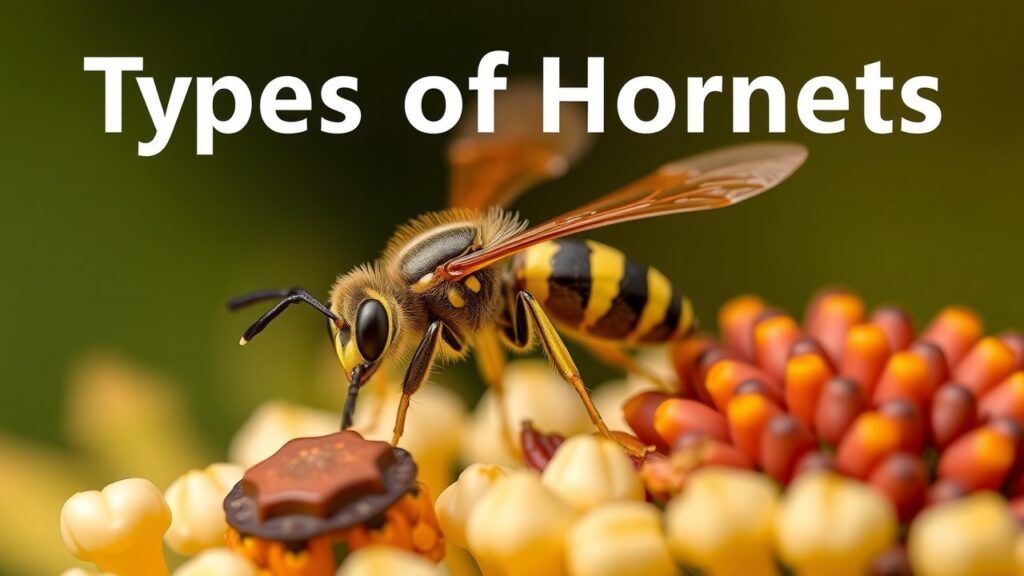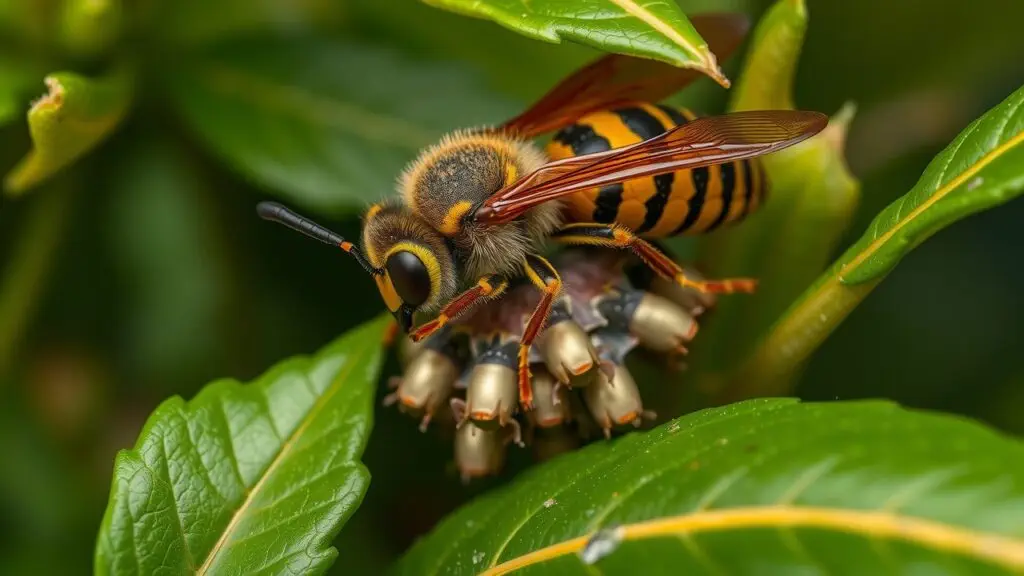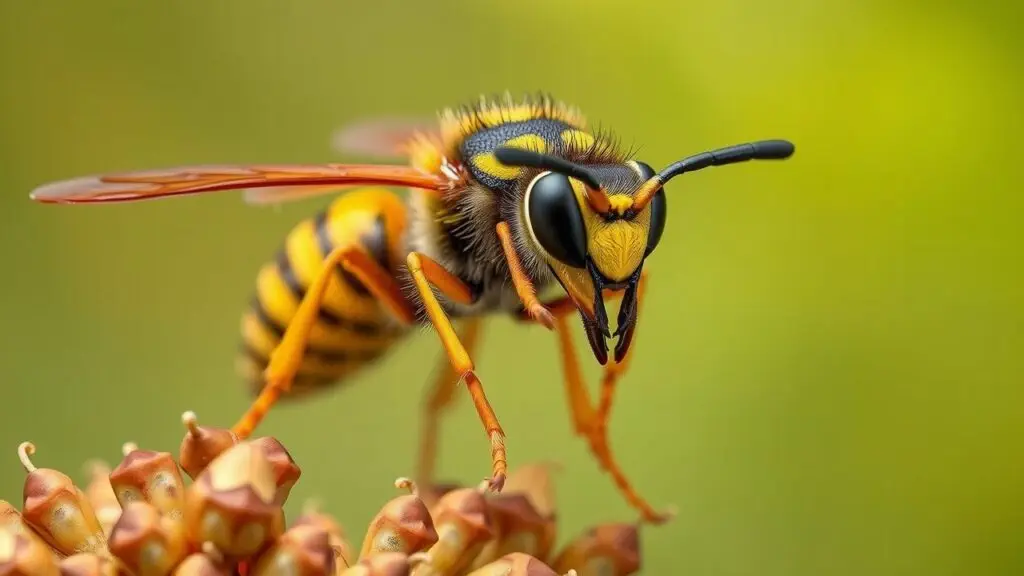Learn about the different types of hornets with this guide. We cover common species, their nest locations, and their habitats, helping you understand these insects better.
What Are Hornets?

Hornets are big bugs that belong to the Vespa genus. They are part of the Vespidae family, which also includes other stinging insects like wasps and bees. Hornets are known for their size and how they behave in groups, which is different from other flying insects. Knowing how to tell them apart is really important.
Differences Between Hornets, Wasps, and Bees
Hornets stand out from wasps and bees in a few ways:
- Size: Hornets are usually bigger than most wasps and bees. For instance, a European hornet can grow up to 1 inch long.
- Behavior: While hornets, wasps, and bees all fall under the Hymenoptera order, hornets can be more aggressive. They tend to protect their nests more fiercely than many wasp or bee species.
- Sting Potency: The venom from a hornet’s sting is generally stronger than that of common wasps or bees. This means getting stung by a hornet can hurt a lot more.
- Nesting Habits: Hornets create nests that look like paper and usually hang high in trees or under roofs. On the other hand, some wasps make smaller nests closer to the ground.
Knowing these differences helps with correctly identifying various types of hornets.
Why Is Identifying Hornet Species Important?
Identifying different types of hornets matters for several reasons:
- Safety Concerns Due to Varying Aggression Levels: Some hornet species can be very aggressive when they feel threatened. For example, bald-faced hornets will defend their nests quite fiercely if you get too close.
- Importance for Pest Control Strategies: When you know which type of hornet is around, it helps in deciding what to do about them. Different species might need different management methods if there’s a problem.
- Contribution To Ecological Understanding: Hornets help keep insect populations in check and play a role in pollination. By knowing about different species, we can better understand their roles in nature.
By learning about these aspects, people can interact with these interesting creatures safely while appreciating their importance in our ecosystems.
Common Types of Hornets Globally
Asian Giant Hornet (Vespa mandarinia)
The Asian giant hornet, or Vespa mandarinia, is one of the biggest hornets in the world. It can grow up to 2 inches long! This hornet has a bright orange-yellow head and a dark body with yellow stripes on its abdomen. These features make it stand out and easy to spot.
This hornet lives mainly in East Asia. You can find it in countries like Japan, China, and Korea. A map showing these areas would be helpful for understanding their range.
When it comes to behavior, this hornet can be pretty aggressive if it feels threatened. They usually build their nests underground, using old rodent burrows or tree roots. In a single nest, there can be hundreds of hornets during peak season.
The venom of the Asian giant hornet is very strong. It can cause severe pain for humans and animals. Research shows that their stings might lead to allergic reactions or even anaphylaxis in some people. Their venom contains neurotoxins that can harm human tissues and affect immune responses.
European Hornet (Vespa crabro)
The European hornet, known scientifically as Vespa crabro, has reddish-brown markings and a bright yellow head. This coloring makes it quite distinct from other species. These hornets are smaller than the Asian giant ones, usually measuring between 1-1.5 inches long.
You can find European hornets across Europe and parts of Asia. They do well in temperate climates where they like to build nests high up in trees or inside buildings, like attics or wall spaces. This is different from many other hornets that prefer open areas for nesting.
European hornets are not as aggressive as some other types unless you provoke them. They will defend their nests fiercely if disturbed.
Other Notable Species Briefly Covered
Asian Hornet (vespidae) Region-Specific Populations
The Asian hornet is part of the Vespidae family and has been growing in number outside its original area due to global trade routes. Places like France and Spain now see these hornets more often, which can harm local ecosystems by hunting honeybees.
These hornets prefer living near cities where food is easy to find. They hunt differently than other species, going after various pollinators instead of just scavenging for food.
Hornet Identification
Visual Identification
Identifying hornets can be hard. They often look similar to wasps and bees. Knowing their physical traits helps a lot. Here’s a guide to spot different hornets.
Key Features for Hornet Identification
- Size: Hornets are usually bigger than wasps and bees. The Asian giant hornet can grow up to 2 inches long, while European hornets range from 1 to 1.5 inches.
- Body Shape: Hornets have a thicker body than wasps, which are longer and skinnier. The bald-faced hornet has a unique black-and-white pattern that makes it easy to spot.
- Color Patterns: Different hornet species show various colors:
- The European hornet has yellow and brown stripes.
- The bald-faced hornet is mainly black with white markings on its face.
- The Asian giant hornet has orange-yellow bands on its abdomen.
- Wings and Legs: Hornets have big wings compared to their body size. They fold their wings flat against their bodies when resting, unlike many bees that keep theirs out.
To help you recognize these insects, look at high-quality images showing these traits side by side with similar stinging insects like wasps and bees.
| Feature | Hornets | Wasps | Bees |
|---|---|---|---|
| Size | Larger (up to 2 inches) | Smaller (0.5-1 inch) | Varies (0.5-2 inches) |
| Body Shape | Thick | Slimmer | Stocky |
| Color Patterns | Yellow/brown or black/white | Bright yellow/black | Brownish/yellow |
| Wing Position | Folded flat | Outstretched | Outstretched |
Knowing these differences helps in identifying hornets while enjoying nature or handling pest control.
Geographic Location
The area where you find hornets matters for identification because some species live only in specific regions.
Distribution of Common Hornet Species
Hornets exist in many parts of the world:
In North America:
- The bald-faced hornet is common across Canada and the U.S.
- European hornets have been spotted in the eastern U.S., coming from Europe.
In Asia:
- The Asian giant hornet lives mainly in Japan, China, and Korea but has recently been found in parts of North America too.
Knowing where different species live helps you identify them better.
Safety Precautions
When you see a stinging insect like a hornet, your safety is super important.
Safe Identification Practices
Here are some key safety tips:
- Don’t get close to nests; they can be aggressive if they feel threatened.
- If you see a nest near your home or work, call professionals for removal instead of trying it yourself.
If you do get stung by a hornet:
- Wash the sting area with soap and water right away.
- Use ice packs wrapped in cloths to reduce swelling.
- Watch for any allergic reactions; get medical help if needed.
Following these steps keeps you safe and respects wildlife related to stinging insects like the different types of hornets we see!
Hornet Nests and Habitats

Nest Locations
Hornets have interesting ways of building their nests. Different hornet species like different places to settle down. Here are some common nest locations:
- Underground Nests: Some hornets dig into the ground to make their homes. They often use old mouse burrows or dig small holes. The entrances are usually small, which keeps them hidden from enemies.
- Tree Cavities: Many hornets like to build their nests inside tree trunks or branches that are hollow. This gives them a safe spot to raise their young.
- Buildings and Attics: In cities, hornets often choose attics, eaves, or wall spaces in houses for nesting. These areas are warm and provide good protection.
Hornet nests are made from a paper-like substance. They chew wood fibers mixed with their saliva to create strong nests. Depending on the species, a nest can hold anywhere from hundreds to thousands of hornets.
Each species has its own preferences based on where they live. For example, the bald-faced hornet likes to build its nest high in trees, while others may prefer lower spots.
Habitat Preferences
Hornets are found in many places, from thick forests to busy cities. Their habitats help them survive and thrive:
- Forests: Hornets enjoy living in wooded areas where they find plenty of flowers for food and trees for building nests. The trees offer cover from predators too.
- Urban Areas: As more people move into natural spaces, some hornets adapt well to city life. They build nests near homes and gardens where food is easy to find thanks to gardens and landscaping.
Weather also affects where hornets can live. In warmer climates, hornets tend to have bigger populations because they need warmth to be active during spring and summer when they search for food.
By knowing where hornets like to nest and their habitat needs, we can better understand these insects and their roles in our environment.
Hornet Behavior and Ecology
Hornets are interesting insects. They play important roles in nature. Understanding their behavior, diet, and impact can help us see how they fit into the ecosystem.
Social Structure
Hornets live in colonies with a clear social order. The queen hornet is at the top. Her main job is to lay eggs. These eggs will grow into new workers or drones.
Workers have several important tasks:
- They find food.
- They build and repair the nest.
- They care for the young.
Without workers, the colony wouldn’t survive. Drones have a special role too; they mate with queens from other colonies during mating season. After this, drones usually die because they don’t do anything else in their own colony.
Diet and Predation
Hornets eat different types of food depending on their species. They often scavenge for food and hunt smaller insects. Here are some things they might eat:
- Other insects like flies and caterpillars
- Nectar from flowers
- Pollen when it’s available
This mix of food helps them adapt to various places while keeping insect populations in check.
Ecological Role
Hornets have important jobs in their ecosystems as both predators and prey. As hunters, they control pest populations by eating bugs like aphids or beetles that can harm plants. This natural way of controlling pests helps maintain balance in nature.
Additionally, hornets serve as food for larger animals such as birds or mammals when there are many of them around. Their presence supports healthy ecosystems through these predator-prey relationships, which keep environments stable across many areas.
Hornet Stings and Human Interaction
Hornets can deliver painful stings. These stings can lead to discomfort and, in some cases, serious health problems. Knowing about hornet stings is important for anyone who might encounter them.
Venom Potency and Sting Severity
Hornet venom has proteins that affect skin cells, the immune system, and nerves. This makes a hornet sting hurt a lot. The pain level depends on the type of hornet. For instance, the Asian giant hornet has very strong venom. A sting from this hornet can cause severe pain that lasts for several hours.
Aggressiveness Levels
Hornets act differently based on their species. Some are more aggressive than others. European hornets usually stay calm unless threatened. In contrast, bald-faced hornets become defensive when someone gets too close to their nests. Knowing how these insects behave can help people avoid getting stung.
First Aid for Stings
If someone gets stung by a hornet, it’s important to act fast:
- Remove the Stinger: If you see a stinger, carefully scrape it out using something flat like a credit card.
- Clean the Wound: Wash the area with soap and water to lower infection risk.
- Apply Ice: Use an ice pack wrapped in cloth to help reduce swelling.
- Take Antihistamines: Over-the-counter antihistamines can ease itching and swelling.
- Monitor for Allergic Reactions: Keep an eye out for signs like trouble breathing or swelling beyond where you were stung; if these happen, seek medical help right away.
Being aware of possible allergic reactions is really important because some people can have anaphylaxis after getting stung by certain hornets.
Dealing with Hornet Nests
If you find a nest, don’t try to remove it yourself; this can be risky due to aggressive behavior from the wasps protecting their home. Instead, reach out to professional pest control services that know how to safely get rid of nests without putting anyone in danger.
Learning how to safely interact with hornets can help keep you safe while enjoying outdoor activities!
Hornet Control and Prevention

Hornets can be quite a bother, especially when they make nests close to homes or outdoor spots. It’s really important to manage hornets well for both safety and comfort. This guide talks about hornet control, including how to spot them, professional removal services, and ways to prevent them from coming back.
Identifying Hornet Nests
Spotting hornet nests is key for good pest management. Hornet nests are usually found in trees, bushes, or under the eaves of buildings. They look like they are made of paper because they’re made from chewed wood fibers mixed with saliva.
Key Traits of Hornet Nests:
- Size: Most hornet nests can be as big as a basketball or even larger than a beach ball.
- Structure: The outside is smooth and grayish-brown because of the paper material.
- Location: You’ll often see them hanging in open spaces. Wasp nests may be more enclosed and smaller than hornet nests.
To tell hornets apart from other insects like wasps or bees:
- Wasp nests are generally smaller and not as round as hornet nests.
- Bee hives look fuzzy because they are made of wax.
Using visual guides can help you recognize these differences fast.
Professional Hornet Nest Removal
If you need to remove hornets safely, it’s best to hire licensed experts. These professionals know how to handle potentially aggressive species without putting themselves at risk during removal.
Trying to do it yourself can lead to problems:
- Disturbing a nest might cause the whole colony to attack.
- Not handling things correctly could lead to painful stings that need medical care.
Professional pest control services use safe removal methods while keeping risks low for everyone involved.
Prevention Strategies
Stopping hornets from nesting near your home means taking some smart steps:
- Sealing Building Openings: Check your house for cracks around windows, doors, and vents where hornets could get inside.
- Removing Food Sources: Keep outdoor eating areas clean by throwing away food waste right away.
- Landscaping Changes: Trim back overgrown bushes where nests might form; also think about planting flowers that don’t attract insects which hornets eat.
By sticking with these tips regularly, homeowners can greatly lessen their chances of unwanted hornets making a home nearby.
Frequently Asked Questions (FAQs)
What is the difference between hornets and wasps?
Hornets are a type of wasp. They are generally larger and more robust than typical wasps. Hornets build larger nests, often in trees or eaves. Wasps might have smaller nests found in sheltered spots. Aggression levels can vary; hornets tend to be more defensive.
How can I identify hornet species?
You can identify hornet species by their size, color patterns, and nesting habits. For example, the bald-faced hornet is black with white markings. The European hornet has reddish-brown stripes and a yellow head.
What should I do if I get stung by a hornet?
If you get stung, wash the area with soap and water. Apply ice to reduce swelling. Antihistamines can help with itching. Watch for allergic reactions like difficulty breathing. Seek medical help if needed.
Where do hornets typically build their nests?
Hornets usually build nests in trees, bushes, or under building eaves. They create large paper-like nests that can hold many individuals. Some prefer underground spots or cavities in trees.
How aggressive are different types of hornets?
Aggressiveness varies among hornet species. Bald-faced hornets are known for their protective behavior. European hornets are less aggressive unless provoked.
Understanding Hornet Life Cycle
- Life Cycle Stages: Hornets develop through four stages: egg, larva, pupa, and adult.
- Queen’s Role: The queen lays eggs in spring to start the colony.
- Worker Hornets: Workers forage for food and care for larvae.
- Drone Mating: Drones mate with queens during late summer.
- Overwintering: In winter, only fertilized queens survive hibernation.
Hornet Ecology and Biodiversity
- Ecological Role: Hornets control insect populations through predation.
- Pollinators: Some hornet species visit flowers, aiding pollination.
- Invasive Species Concern: Certain hornet types threaten native insect populations.
- Conservation Needs: Protecting native habitats helps maintain biodiversity.
Effective Pest Control Methods
- Integrated Pest Management (IPM): Combines biological control with habitat modification.
- Natural Remedies: Essential oils deter hornets without chemicals.
- Safety Precautions: Wear protective clothing when dealing with nests.
- Trapping Strategies: Use traps to capture and monitor populations safely.
Hornet Venom and Human Interaction
- Venom Composition: Hornet venom contains proteins that cause pain and inflammation.
- Severe Reactions: Allergic responses can lead to anaphylaxis in sensitive individuals.
- First Aid Techniques: Follow first aid guidelines promptly after a sting.
Geographic Range of Common Hornets
- North American Species: Includes bald-faced hornets and European hornets.
- European Habitat: The European hornet thrives in temperate climates across Europe.
- Asian Distribution: The Asian giant hornet is mainly found in East Asia but has spread globally.
Related Topics
- Types of Hornet Nests
- Types of Hornet Stings
- Types of Hornet Venom
- Types of Hornet Control Methods
- Types of Hornet Habitats
- Types of Hornet Aggression
- Types of Hornet Prey
- Types of Hornet Predators
- Types of Hornet Removal Services



Types of Hornets: A Guide to Common Species, Nests, and Habitats